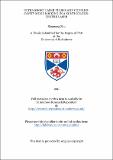Files in this item
Ultra short laser pulses and coupled-cavity mode locking in a KCI:TI colour-centre laser
Item metadata
| dc.contributor.advisor | Sibbett, Wilson | |
| dc.contributor.author | Zhu, Xiaonong | |
| dc.coverage.spatial | 329 p. | en_US |
| dc.date.accessioned | 2018-06-07T11:21:49Z | |
| dc.date.available | 2018-06-07T11:21:49Z | |
| dc.date.issued | 1991-07 | |
| dc.identifier.uri | https://hdl.handle.net/10023/13804 | |
| dc.description.abstract | The basic principles of generation, characterisation and propagation of ultrashort laser pulses and related experimental studies of mode locking of a coupled-cavity KC1:Ti colour-centre laser are presented. Extensive experimental investigations of mode locking with a two-cavity arrangement similar to a previously reported soliton laser has indicated that such a scheme is a very general technique for the generation of picosecond- femtosecond pulses. With or without the formation of optical solitons in the control fibre a variety of spectral and temporal features for the laser output pulses can be obtained. This new type of pulse generation technique has thus been named as "coupled-cavity mode locking" and it has been shown in this work that the coupled-cavity mode-locked KC1:Ti colour-centre laser is a very useful femtosecond laser source. Through replacing the traditional electron-optical streak camera tube by an optical Kerr material and using the optical (pulse) beam to scan the pulse(s) to be measured, a novel pulse measurement method have been proposed. For this new measurement scheme no electron-photon transformation and any other electronic systems are involved, and therefore it is expected to have the advantages of easy operation and high resolution. Study of the relationship between the temporal and the spectral features of an optical field suggests that a Fourier transform of a first-order spectral autocorrelation of a femtosecond pulse will give rise to the intensity profile of the pulse. A schematic for the measurement of the first-order spectral autocorrelation is also configurated. A strong similarity between the impact of dispersion on the temporal feature and that of self-phase modulation on the spectral feature of optical pulses has been found. This leads to two important inferences: first, the spectral extension induced by self-phase modulation is linearly proportional to the peak optical intensity only when the associated nonlinear phase shift is sufficiently large, second, if the incident pulses are appropriately chirped a suitable length of SPM-medium can be used to compress the incident spectrum (rather than broaden it). To initiate coupled-cavity mode locking a minimum optical power coupled into the control cavity is required. The specific value of this threshold is not only dependent on the properties of the nonlinear medium such as the length of the fibre, the magnitude of the Kerr coefficient, but also on the main cavity parameters, e. g. the main cavity power level and the effective gain bandwidth. Such a fact simply illustrates that to understand the physical mechanisms involved in the coupled-cavity mode locking the interactive function of various factors in both cavities must be considered. The upper-limit of the nonlinear phase shift, phiNL, experienced by the pulses coupled into the control cavity is found to be phiNL ≤ 2TC. Above this value, further increase of the intrafibre power would lead to the laser operation in an unstable regime. In addition, if the peak optical intensity inside the fibre core is sufficiently high the other nonlinear effects such as modulational instability and self-Raman action can occur besides self-phase modulation. In these cases the process of mode locking enhancement may be frustrated. By incorporating an Er-doped mono-mode optical fibre in the control cavity of such a coupled-cavity mode-locked KCl:Ti laser has led to the generation of 75 fs pulses at 1.5 mum. This result represents the shortest pulses produced with this method in a non-soliton regime. | en_US |
| dc.language.iso | en | en_US |
| dc.publisher | University of St Andrews | |
| dc.subject.lcc | TK7871.3U6Z9 | |
| dc.subject.lcsh | Lasers | |
| dc.title | Ultra short laser pulses and coupled-cavity mode locking in a KCI:TI colour-centre laser | en_US |
| dc.type | Thesis | en_US |
| dc.contributor.sponsor | Sino-British Friendship Scholarship Scheme | en_US |
| dc.type.qualificationlevel | Doctoral | en_US |
| dc.type.qualificationname | PhD Doctor of Philosophy | en_US |
| dc.publisher.institution | The University of St Andrews | en_US |
This item appears in the following Collection(s)
Items in the St Andrews Research Repository are protected by copyright, with all rights reserved, unless otherwise indicated.

